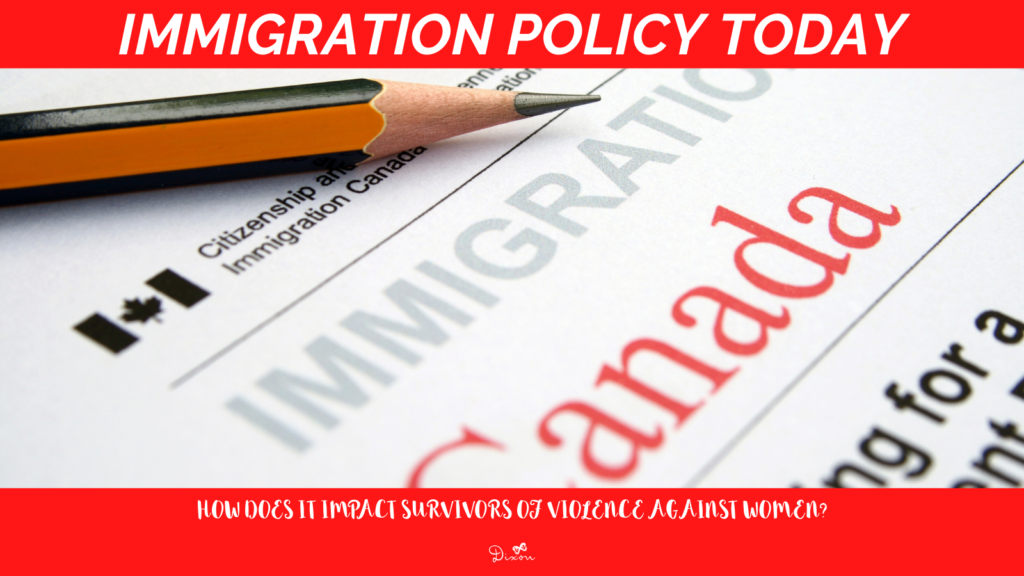
If you’ve never navigated the process of becoming a Canadian citizen, you might not understand just how complicated this process is. Today we’re going to look at the Canadian citizenship process, and how this can be a barrier for immigrant women fleeing violence.
How Do I Become a Canadian Citizen?
Canada’s immigration system first and foremost looks at an applicant’s connections to Canada, as well as their achievements. Immigrants who have a broader network of social and professional connections in Canada have a much easier time becoming citizens than those who don’t.
About 39% of immigrant women enter Canada as a sponsored spouse. As a sponsored spouse they are required to cohabit with their partner for two years if they want to pursue Canadian citizenship eventually. Many immigrant women fear reporting abuse because they are concerned their status in Canada will be jeopardized.
It is an understatement to say Canada’s immigration system is extremely complex, and constantly changing. Many immigrants are understandably confused about their status in Canada at any given time– this makes it especially difficult for immigrant women experiencing violence to know what they can and can’t do to flee from their abuser without risking their status in Canada.

The Good
In Canada, immigrant women who are survivors of domestic violence can apply for citizenship or permanent residency under humanitarian and compassionate (also known as H and C) grounds. Immigrant women can also receive a temporary resident permit (also known as a TRP) without having to testify in court against their abuser.
A TRP has no application fee, can be renewed, and provides access to healthcare and counselling services for immigrant survivors. A TRP also functions as a work permit, which allows immigrant survivors to earn an income.
Some immigrant women who have experienced domestic violence may want to return to their home country, while others may want to stay in Canada. A TRP allows women legal status in Canada so they have time to consider this decision without fear of deportation.

The Bad
A TRP sounds like a great option, but it is only a temporary solution as immigrant survivors must eventually apply for citizenship or permanent residency under H and C grounds. In a survey of immigration attorneys across Canada, Alaggia et al. (2009) notes that only 3-48% of appeals made by survivors of domestic violence under H and C grounds successfully lead to residency or citizenship in Canada.
It is also important to note that the entire H and C process can take 18-24 months to complete from application to residency. For women experiencing violence, this means that they may be stuck in an unsafe situation for nearly two years.
H and C grounds create a Catch-22 for immigrant women. To successfully be granted citizenship or residency, a survivor must provide medical or legal evidence of the abuse she has endured. Many survivors fail to obtain this evidence, because they fear seeking help from doctors or police officers will threaten their ability to stay in Canada. But without this evidence, a survivor cannot obtain H and C status in Canada.
The H and C process also has a rather high standard for immigrant women to meet: they need to demonstrate a broad social network and ties to their community. However, this can be challenging when you’ve recently migrated to a new country and experienced the isolation that often accompanies domestic violence.
The H and C process is, in principle, an important policy that allows immigrant survivors of domestic violence to remain in Canada if they have fled an abuser. But in practice, this policy is much more complicated and doesn’t serve immigrant women to the extent it could.

The Ugly
Many immigrant women also face significant language barriers and unreliable access to translation/interpretation resources. This can make navigating the highly complex Canadian immigration system increasingly difficult.
It is also worth noting the trauma that immigrant women must endure if they want to remain in Canada legally. To successfully be granted residency or citizenship under H and C grounds, immigrant women must disclose their experiences of violence in medical and legal settings that are rarely culturally safe spaces.
And as Alaggia et al. (2009) remind us, these disclosures are far from a guarantee a survivor can remain in Canada. For many immigrant women, the H and C process yields lots of trauma and little results.
How Can We Help?
It is key that we increase the collaboration between the anti-violence services sector (organizations like Dixon) and Canada’s immigration system. Together, we can work to ensure immigration policies that pertain to survivors of domestic violence are both culturally and trauma informed.
Interesting in learning more about other reforms and best practices to keep immigrant women safe? Keep an eye out for our next post, where we take a deeper look at what works, and what doesn’t.
No matter where you are from or how long you’ve lived in Canada, you have the right to live a life free of violence. Whatever your status in Canada is, Dixon is here to help!
Further Reading
Alaggia et al. 2009, “Intimate partner violence and immigration laws in Canada: How far have we come?”https://refugeeresearch.net/wp-content/uploads/2016/05/Alaggia-et-al-2009-Intimate-partner-violence-and-immigration-laws-in-Canada.pdf
Government of Canada, “Immigration options for victims of family violence” https://www.canada.ca/en/immigration-refugees-citizenship/services/immigrate-canada/family-sponsorship/fees-permits-victims.html
MOSAIC and EVA-BC, “The Immigration Refugee Protection Act, Regulations and CIC Policies: How do they impact women’s Charter rights and women’s
safety?” https://endingviolence.org/wp-content/uploads/2014/03/IWP-_The_Immigration_Refugee_Protection_Act.pdf
Canadian Council for Refugees, “Violence Against Newcomer Women” https://ccrweb.ca/en/violence-against-women
VisaPlace, “Humanitarian and Compassionate Applications” https://www.visaplace.com/canadian-immigration/canada-permanent-residence/humanitarian-compassionate/#:~:text=Applications%20can%20take%20around%2018,during%20the%20H%20%26%20C%20process.

